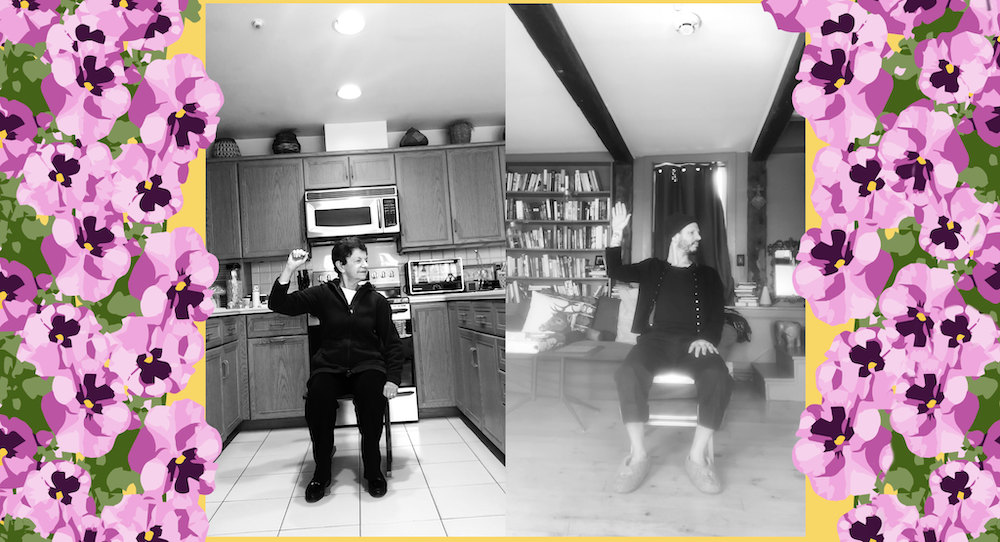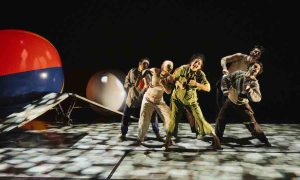Premiered May 7, 2021.
Available at collisionshop.org.
If asked, you might not think that dance and technology are natural partners. Yet, innovative dance artists are leveraging technology, and fruitful collaborations with STEM professionals, to enliven and diversify what dance can be. A key example of this phenomenon is COLLISION SHOP out of the Massachusetts Institute of Technology’s Music and Theatre Arts, conceived and facilitated by Dan Safer.
It’s an open and interactive website that leads viewers through videos of different performers performing the same script — varied creative choices as well as the unique personalities of the performers resulting in something new and different each time. The performers come to the work with openness, honesty and joy, resulting in something light-hearted but also mindful — perhaps just the sort of thing that the world needs circa 2021. The performers also submitted their videos from all over the world, bringing a diversity and universality to the project as well.
The script that these performers all execute is straightforward and uncomplicated — which, as one factor amongst others (those which we’ll get into) leaves space for them to bring their own authentic choices to it. Upon entering the site, viewers can choose to “Curate” (choose videos to watch, from a panel of thumbnails) or “Collide!” (the site choosing for you) — which brings an element of postmodern interactivity, versus audience members being fully passive receivers of the work at hand. I start with “Collide!” and then move on to “Curate”.
Each video features two performers through a split screen, bordered with a lush wreath of digital flowers. They begin by dancing, improvising until words across the screen alert them that it’s time for “true or false.” They sit with a false answer and stand up with a true answer. That’s a seemingly binary choice, but performers bring more possibilities to it through their unique movement choices.
True-or-false questions include “I am short,” “I am tall,” “I am young,” “I am old,” “I am an immigrant,” “I am a child of an immigrant.” Movement isn’t typically how we share things about ourselves — but this structure allows for that.
Then comes a short movement section, each performer dancing their own movement vocabulary — yet, it’s vocabulary that seems to evince a movement conversation between the two performers. In most of the videos, one dancer moves with technical, codified movement and the other with a more pedestrian quality. This is a juxtaposition layered on the existing juxtaposition of dance and technology, building intriguing layers to peel back.
Then come more questions, to which performers are instructed to answer with “true” by moving towards the camera and “false” by moving away from it. These questions get even deeper and more personal than the ones in the prior batch — “I am an introvert,” “I believe that people are inherently good,” “I am a good person,” “I believe that billionaires shouldn’t exist,” “I believe that everyone has a purpose.” Adding even more possibilities to a seemingly binary choice of movement, the prompter instructs the performers to “boogie!” as they move forward and back — and, in their own ways, boogie they do!
The performers’ next task is to embody emotions — happy (“even happier!”) and angry (“even angrier!”). Lighting changes to black and white and red filters, respectively, to enhance the feeling of the emotion at hand. Then they have seven seconds to find something “tiny.” Some of the performers are outside — and therefore get things like flowers or pebbles — and some are inside, so they get little office supplies, tools, or personal care items. Within all of these sections is a game-like quality that’s both clever and straightforward — engaging and enticingly unpredictable.
The performers end with an improvisation, which leads into a sped-up section — them flying through movement and at times, kids, roommates, pets and others coming in and out of the screen. It’s fascinating to think that we can manipulate time — at least in a visual sense — so that we can see multiple moments happening in a singular moment. After this time-altered section, performers take their own version of a bow, with digital confetti and cheering sound effects congratulating them.
That’s the standard script for each of the videos. Yet no two videos are exactly alike; variations in elements like music and lighting effects, as well as different performer’s movement choices and their unique personalities shining through, make each video its own little joy to experience.
One score is upbeat, jazzy and theatrical. Another is pensive, ambient electronica, and yet another a stitching together of various sound effects — from natural sounds like birds chirping to slightly atonal human vocalizations. It’s fascinating to see the different stylistic colors and flavors that these different scores bring to the same script, video after video. Varied lighting choices from video to video also add literal differences in color and visual flavor. These elements together, each video becomes a new visual and auditory nugget of discovery.
Also intriguing me are the different pairings of performers. An expansive, energetic outdoor improvisation from one dancer offsets the more pedestrian, more reserved movement of her partner (indoors) — an exhibit A of the contrast created through pairing a technical, codified mover with a more pedestrian one in many of the videos. In another video, the dancer moving more expansively and technically reflects the mysterious, resonant tones in the score — one that could be in the background of a movie about astronauts and outer space.
Performers’ personalities on display, as well as pairings of opposing personalities, is something else piquing my interest in several videos. In one video, one performer seems to have a reserved personality and the other a gregarious one, for example. In the sped-up section towards the end, the more gregarious performer dances with family members and the more reserved one puts on headphones and knits, which — without knowing these individuals — makes sense!
Also fascinating is getting a sense of these individuals’ self-perceptions — by how they answer the “true” and “false.” One who appears young answers “true” to “I am old,” and another who appears average-height to tall also answers “true” to “I am short”, for example. That combined with the simple facts that viewers can learn about them (if they are an immigrant and even a bit on their views on class politics, for instance) offers a glimpse into who they are as people — without them ever speaking a word.
True, I could understand some viewers tiring of watching the same script presented over and over again, even with all of those described textures and tones that vary from video to video. I myself start to feel it towards the end of my time on the site. Yet that ability to learn more about fellow humans, in a fresh and innovative way — that’s a gift. The honesty and authenticity that these artists bring, as well as the foundational structure of dance and technology coming together in a unique way, make that gift all the sweeter.
It’s hard to hate up close, they say. Art like Collision Shop can remind us of our shared humanity — no matter our race, gender, religion, political affiliation, or any other part of our identity — while making us smile, laugh, ponder, and more. I’ve said it before and I’ll say it again — art is magic!
By Kathryn Boland of Dance Informa.















